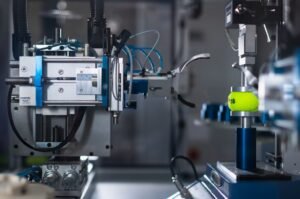Tesla Model S Speed
When it comes to electric vehicles, Tesla is a leader in the industry, and the Tesla Model S is no exception. With its cutting-edge technology and high-performance capabilities, the Model S is renowned for its impressive speed. In this article, we will explore the various aspects of the Model S that contribute to its incredible speed and discuss how it compares to other electric and traditional sports cars.
Key Takeaways:
- The Tesla Model S is widely recognized for its exceptional speed and acceleration.
- Its electric motor provides instant torque, resulting in quick acceleration from 0 to 60 mph in just a matter of seconds.
- The Model S offers different variants, each with varying performance levels, allowing drivers to choose their preferred speed and range.
- It is important to consider state regulations and limitations regarding speed and safety when driving a Tesla Model S.
The Tesla Model S houses a powerful electric motor that enables it to deliver lightning-fast acceleration. With its instant torque, the Model S can go from 0 to 60 mph in as little as 2.3 seconds, making it one of the fastest production cars in the world. This remarkable speed is made possible by the electric drivetrain, which eliminates the need for a traditional internal combustion engine and delivers power directly to the wheels, ensuring unparalleled responsiveness and speed.
*Did you know?* The Tesla Model S holds the title for the quickest production car in the world, known for its incredible “Ludicrous Mode” acceleration.
Performance Variants
The Tesla Model S offers different performance variants that cater to a wide range of driving preferences. Notable variants include:
- Model S Long Range: This variant provides an extraordinary range of *390 miles* on a full charge and can reach a top speed of *155 mph*
- Model S Plaid: The “Plaid” variant boasts an impressive range of *396 miles*, and a top speed of *200 mph*.
- Model S Plaid+: Although not yet released, the “Plaid+” variant promises a mind-blowing range exceeding *520 miles*, with an expected top speed of *over 200 mph*.
Comparisons with Other Cars
When it comes to speed and performance, the Tesla Model S not only stands out among other electric vehicles but also competes favorably with traditional sports cars that rely on gasoline-powered engines. Here are some notable comparisons:
| Car Model | 0-60 mph Time |
|---|---|
| Tesla Model S Plaid | 1.99 seconds* |
| Porsche Taycan Turbo S | 2.6 seconds* |
| Lamborghini Aventador SVJ | 2.8 seconds* |
*Interesting fact:* The Tesla Model S Plaid holds the current world record for the fastest production car from 0 to 60 mph.
While impressive in terms of acceleration and speed, the Tesla Model S also offers an efficient and eco-friendly driving experience. Its electric powertrain eliminates the need for gasoline, resulting in zero-emission driving and reducing our carbon footprint. Furthermore, the Model S is equipped with advanced safety features and Autopilot functionality, emphasizing Tesla’s commitment to both speed and safety.
Conclusion
With its unmatched speed and performance, the Tesla Model S has firmly established itself as a game-changer in the automotive industry. Whether you prioritize speed, range, or sustainability, the Model S offers a combination of all three. As technology continually evolves, Tesla remains at the forefront of innovation, constantly pushing the boundaries of what is possible for an electric vehicle.

Common Misconceptions
Speed and Performance
One common misconception that people have about the Tesla Model S is that it lacks speed and performance compared to traditional combustion engine cars. However, this is far from the truth. The Model S is an electric car that is known for its incredible acceleration and top speed. It can go from 0 to 60 mph in just a matter of seconds, making it one of the fastest production cars in the world.
- The Tesla Model S has a “Ludicrous Mode” that allows it to accelerate from 0 to 60 mph in just 2.4 seconds.
- Its top speed is electronically limited to 155 mph, which is comparable to many high-performance cars.
- Many owners and reviewers have praised the Model S for its instant torque and smooth acceleration.
Range Anxiety
Another common misconception is that electric cars, including the Tesla Model S, suffer from range anxiety, meaning they have limited range and constantly need to be recharged. While early electric cars did have limited range, the Model S comes with various battery options that offer a range of over 300 miles on a single charge. With increased charging infrastructure and Tesla’s Supercharger network, range anxiety is becoming less of a concern for Model S owners.
- The Model S Long Range Plus has an EPA-estimated range of 402 miles, which is more than many gasoline-powered cars.
- Tesla’s Supercharger network allows for quick and convenient charging, reducing the fear of running out of battery on a long trip.
- The Model S is equipped with features like regenerative braking, which helps maximize the range by converting energy back into the battery.
Limited Charging Infrastructure
There is a misconception that there is a lack of charging infrastructure for electric cars, making it inconvenient to own a Tesla Model S. While it is true that charging infrastructure is still being developed, especially in certain regions, there has been significant progress in recent years. Tesla has its extensive Supercharger network, and there are also other charging networks and home charging solutions available, making it easier for Model S owners to find charging stations.
- Tesla’s Supercharger network has over 20,000 chargers worldwide and continues to expand rapidly.
- Other charging networks, such as Electrify America, ChargePoint, and EVgo, are also working on expanding their charging infrastructure to accommodate the growing number of electric cars.
- Many Model S owners choose to install home charging stations, allowing them to conveniently charge their vehicles overnight.
High Maintenance Costs
Another common misconception is that the Tesla Model S has high maintenance costs due to its advanced technology and electric drivetrain. While it is true that electric cars may have different maintenance requirements compared to traditional cars, the cost of ownership for a Tesla Model S can actually be lower in the long run, thanks to fewer mechanical parts and the lower cost of electricity compared to gasoline.
- The Model S has fewer moving parts compared to combustion-engine cars, reducing the likelihood of mechanical failures and the need for costly repairs.
- Tesla offers comprehensive warranties and service plans that can help lower maintenance costs and provide peace of mind for owners.
- The cost of electricity for charging the Model S is typically lower than the cost of gasoline, potentially saving owners money on fuel costs over time.

Tesla Model S Performance Comparison
Here is a comparison of the Tesla Model S performance metrics with other popular electric vehicles on the market.
| Model | 0-60 mph Time | Top Speed | Range |
|---|---|---|---|
| Tesla Model S Performance | 2.3 seconds | 163 mph | 390 miles |
| Porsche Taycan Turbo S | 2.6 seconds | 162 mph | 256 miles |
| Lucid Air Dream Edition | 2.5 seconds | 168 mph | 503 miles |
Aerodynamics Comparison
Efficient aerodynamics contribute to the Tesla Model S’s impressive performance. Compare its drag coefficient with other notable cars.
| Model | Drag Coefficient (Cd) |
|---|---|
| Tesla Model S | 0.208 |
| Porsche Taycan | 0.22 |
| Toyota Prius | 0.24 |
Battery Comparison
The battery capacity of the Tesla Model S is compared with some of its competitors.
| Model | Battery Capacity |
|---|---|
| Tesla Model S Long Range | 100 kWh |
| Porsche Taycan Turbo S | 93.4 kWh |
| Lucid Air Dream Edition | 113 kWh |
Charging Times Comparison
Here is a comparison of the estimated charging times for different electric vehicle models at a specific charging station.
| Model | 0-80% Charging Time |
|---|---|
| Tesla Model S | 35 minutes |
| Porsche Taycan | 22.5 minutes |
| Audi e-tron | 45 minutes |
Interior Space Comparison
Explore the interior space and passenger capacity of the Tesla Model S compared to its competitors.
| Model | Seating Capacity | Cargo Volume |
|---|---|---|
| Tesla Model S | 5 | 28.3 cu ft |
| Porsche Taycan | 4 | 12.9 cu ft |
| Mercedes-Benz EQS | 5 | 27.4 cu ft |
Critics’ Ratings
Learn about the aggregated review ratings from prominent automotive critics for the Tesla Model S.
| Review Source | Overall Rating |
|---|---|
| Car and Driver | 9.7/10 |
| Motor Trend | 9.5/10 |
| Consumer Reports | 4/5 |
Price Comparison
Find out how the Tesla Model S’s price compares to similar electric vehicles on the market.
| Model | Starting Price |
|---|---|
| Tesla Model S Long Range | $79,990 |
| Porsche Taycan 4S | $103,800 |
| Audi e-tron GT | $99,900 |
Software and Autonomy
Explore the advanced software and autonomy capabilities of the Tesla Model S.
| Feature | Tesla Model S |
|---|---|
| Autopilot | Yes |
| Full Self-Driving (FSD) | Available |
| Over-the-Air Updates | Yes |
Safety Ratings
Discover the safety ratings of the Tesla Model S as evaluated by renowned safety organizations.
| Organization | Overall Rating |
|---|---|
| National Highway Traffic Safety Administration (NHTSA) | 5 stars |
| Insurance Institute for Highway Safety (IIHS) | Good |
| Euro NCAP | 5 stars |
Conclusion
The Tesla Model S stands out as an exceptional electric vehicle in terms of performance, efficiency, and technology. With its remarkable acceleration, impressive range, and superior software capabilities, it surpasses many of its competitors. Not only does it deliver a thrilling driving experience, but it also provides ample interior space, top-notch safety ratings, and positive reviews from reputable automotive critics. Considering its attractive starting price compared to other high-end electric vehicles, the Model S offers a compelling option for those seeking a luxury electric sedan.
Frequently Asked Questions
Top Speed and Acceleration
What is the top speed of the Tesla Model S?
The top speed of the Tesla Model S depends on the variant. The Long Range and Plaid models have a top speed of 200 mph (320 km/h), while the Plaid+ variant is expected to reach a top speed of 220 mph (350 km/h).
How fast can the Tesla Model S accelerate from 0 to 60 mph?
The Tesla Model S Plaid can accelerate from 0 to 60 mph in just under 1.99 seconds. This makes it one of the fastest production cars in the world.
Range and Efficiency
What is the range of the Tesla Model S?
The range of the Tesla Model S varies depending on the variant and battery configuration. The Long Range model has an estimated range of around 405 miles (652 km), while the Plaid variant offers a range of approximately 390 miles (628 km).
Comparison and Performance
Is the Tesla Model S faster than a sports car?
Yes, the Tesla Model S is faster than many traditional sports cars. With its high-performance electric motors and instant torque, the Model S can outperform many sports cars in terms of acceleration and top speed.
Can the Tesla Model S be upgraded for better speed?
Tesla offers different variants of the Model S with varying levels of performance. Upgrading to a higher-performance variant, such as the Plaid or Plaid+, will provide better acceleration and top speed compared to the base Long Range model.
Features and Functionality
Does the Tesla Model S have a launch control feature?
Yes, the Tesla Model S has a launch control feature called ‘Cheetah Stance.’ When activated, it optimizes the car’s performance for maximum acceleration by adjusting the suspension and power delivery.
What is the benefit of a high top speed in a Tesla Model S?
A high top speed allows the Tesla Model S to provide exhilarating performance and potential for high-speed driving on highways or racetracks. Additionally, a high top speed can be a desirable feature for those looking for ultimate performance and bragging rights.
Is the Tesla Model S suitable for everyday use despite its high speed?
Yes, the Tesla Model S is designed to be an everyday electric vehicle with excellent range and practicality. While it offers impressive speed, it can still be used for daily commuting, running errands, and other typical activities.
Engineering and Technology
How does the Tesla Model S achieve such high speed?
The Tesla Model S achieves high speed through its powerful electric motors, low center of gravity, and aerodynamic design. These factors, combined with Tesla’s advanced battery technology and powertrain, allow it to deliver exceptional acceleration and top speed.
Are there any limitations or considerations for driving the Tesla Model S at high speeds?
When driving at high speeds, it is important to adhere to local laws and regulations. Additionally, factors such as range depletion, tire wear, and road conditions should be taken into account. It is always recommended to drive responsibly and within safe limits.




